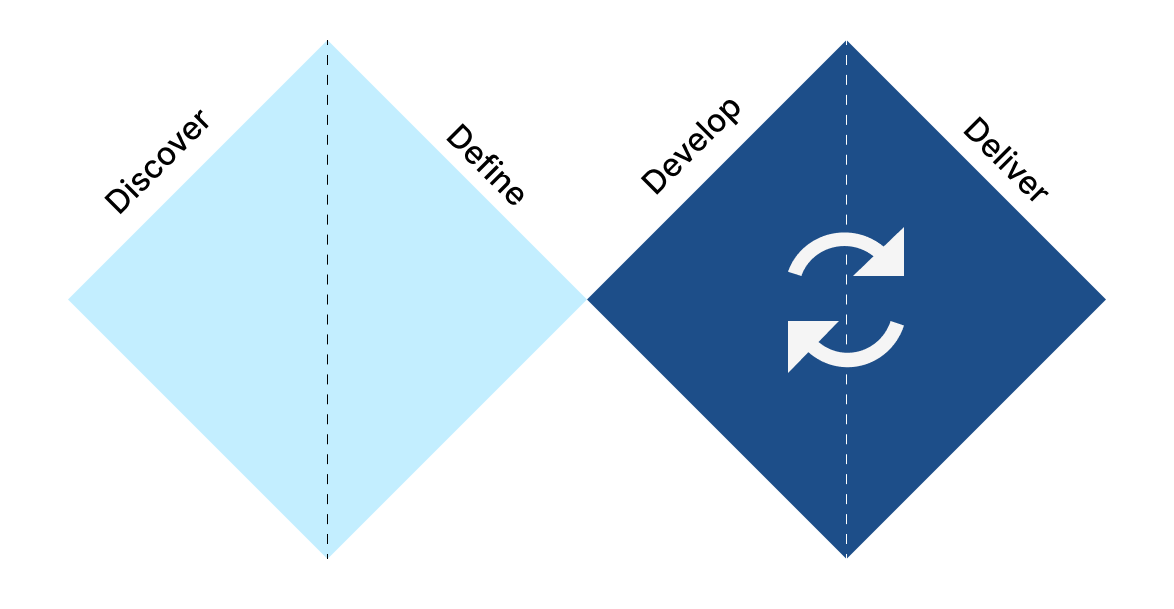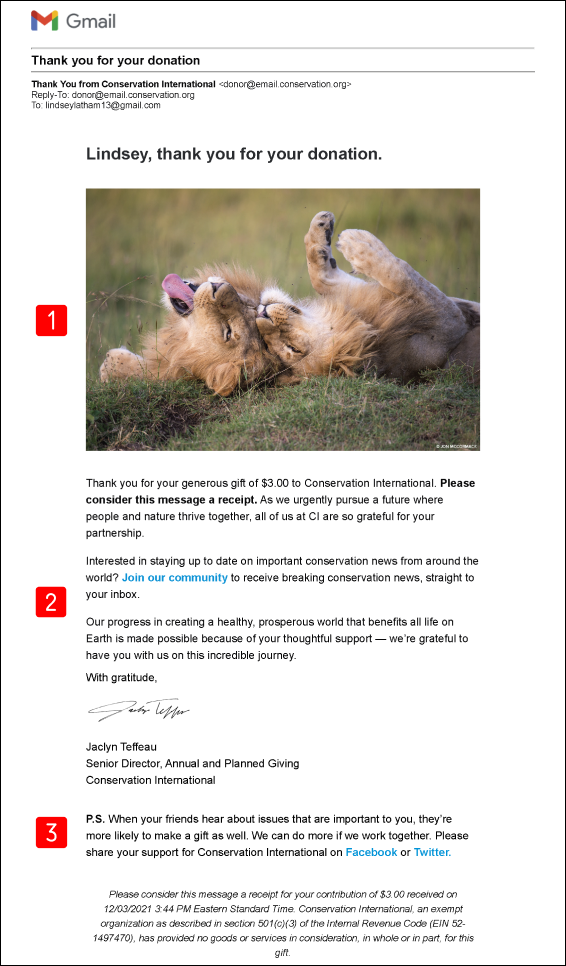Enhancing the Donor Experience to Increase Retention
Client
Conservation International
Timeline
32 weeks
Team
Digital Fundraising Manager / Director of Individual Giving / Brand and Communications
My Responsibilities
Lead User Researcher / Email Designer and Copywriter / HTML Writer
User Group
1,400+ Monthly Donors (‘Sustainers’)
Skills
Survey Design, Quantitative and Qualitative Analysis, Email Design, HTML Writer
Results: In the first 4 months after launch, we achieved a 50.2% decrease in unsubscribes and a 30.85% increase in email clicks. We demonstrated to stakeholders the value of these donors, and cataylzed the long-term business strategy of creating a monthly donor identity.
Overview
Conservation International (CI) is an international non-profit focused on conserving and protecting nature.
The organization has more than 1400 monthly donors (‘sustainers’), who donate over $400,000 each year. These donors provide a predictable and reliable source of unrestricted revenue - or funds which can be allocated by CI where needed most.
🚩 Problem
We noticed a decline in number of monthly donors and an increase in email unsubscribe rates, reducing annual revenue.
A lack of data and outreach restricted our understanding of why.
🎯 Goals
Understand the end-to-end of why sustainers choose to cancel their monthly donations
Discover how sustainers feel about their current donor experience
Uncover frustrations and how to improve the overall experience
Test different email strategies to increase engagement and reduce unsubscribe rates
Improve donor retention with insight-driven campaigns
Before this research…
Conservation International had not tracked monthly donors, completed research, or done targeted outreach - contrary to our donor-first policy and unlike other donor groups with dedicated internal teams.
Because of their lower average monthly donation, CI executives and board members often overlooked these donors, risking loss and missed engagement opportunities.
Key Successes and Insights
Monthly donors had high engagement rates and desired tailored communications that clearly connected their sustaining gifts to specific projects.
Tailored communication changes achieved a 50.2% decrease in unsubscribes and a 30.85% increase in email clicks.
Findings validated our hypothesis
Business Impact
Catalyzed long-term strategy including the launch of the new sustainer identity “The Current” and the development of new member benefits to drive deeper engagement.
Demonstrated to stakeholders that monthly donors were an untapped segment with significant potential, validating the importance of investing in these donors
Methodology and Processes
I crafted a study using the Double Diamond framework to answer our research question.
I used this method to ensure I fully explored donor needs before moving into solution design. This helped me validate the problem space through research, align stakeholders on priorities, and test concepts before implementation, reducing risk and increasing confidence in the final solution.
Process Breakdown
Phase I: Discover
2 weeks
In December 2022, I attended an Association for Fundraising Professionals event on motivations behind why monthly donors cancel their gifts. Inspired to review our donor data, we found a steady decline in number of monthly donors and an increase in their email unsubscribe rates, resulting in loss of revenue.
I led the research to uncover why through these approaches:
Email Engagement and Donor Behavioral Data Analysis
Using Luminate and Raiser’s Edge, I pulled engagement and retention data to analyze sustainer email behavior and patterns:
Analyzed current email engagement KPIs (open rates, reading time, and email volume) to benchmark engagement and spot drop-off points.
Reviewed recent unsubscribers and the specific emails that triggered the action to uncover content or cadence patterns that may be driving disengagement.
Cross-referenced unsubscribers with sustainers who canceled monthly donations in the past 12 months to determine if email disengagement was an indicator of donor churn.
Survey Design and Deployment
I designed and deployed a survey to all 1400+ sustainers. A survey allowed us to reach our entire donor base time efficiently and cost effectively and was built to be scalable for future outreach.
The questions focused on three categories:
Their current donor experience: How satisfied are you with your current monthly donor experience?
Their engagement with CI: How do you stay apprised of CI’s work, if at all?
Their conservation priorities: Which CI initiatives excite you most?
The survey was piloted by two team members on the Individual Giving team before launch.
Semi-Structured Stakeholder Interviews
To align solutions with both donor expectations and organizational goals, I interviewed the VP and Director of Individual Giving, along with the Digital Fundraising Manager, who oversee sustainers and control digital communications.
Questions focused on three key areas:
Historical context: What strategies have been tried in the past, and what challenges were faced?
Organizational priorities: What outcomes are most important to leadership (e.g., donor retention, email subscription rates, donor experience)?
Future goals: How should we make monthly donors feel supported, recognized, and motivated to continue giving?
Phase II: Define
Total Timeline: 2 weeks
Below are the main insights we found through our data analysis.
Email Engagement and Donor Behavioral Data Analysis
Survey Insights (20% response rate)
“I’m surprised I don’t receive more updates on specific projects. It would be nice to get recognition for what I contribute annually.” - Survey Respondent
Current Challenges
Dark imagery, straying from brand guidelines of positivity
Focus is on social share CTAs over thanking donors
Inclusion of mission statement, which felt redundant
Interim Changes
Results: Readers spent an average of 6 seconds reading the new email, a 2 second increase from the prior email.
The interim changes showed small but promising results, giving us reason to continue pursuing this approach.
Utilizing Survey Insights
I developed an email highlighting one of CI’s initiatives and its progress for donors, utilizing the survey insight for their desire for more impact information.
Knowing the time constraint of 8 seconds, I aimed to provide these insights into skimmable emails.
Use of playful, positive imagery in line with brand guidelines
Removed mission statement (assuming sustainers are aware of it)
Moved social share CTAs to P.S. to keep focus on donor thanks
Results: 4% increase in unique clicks for the month it ran. Average email reading times increased to 10 seconds.
Confirming our hypothesis of increased interaction, we focused on boosting email clicks and reading time, believing these KPIs would reduce unsubscribes and ultimately lower monthly donation cancellations. We did this by:
Aligning copy with the top two sustainer priorities: (1) Stabilizing the climate by protecting and restoring nature, and (2) Helping people and nature thrive together
Shortening email length to encourage full reads over skimming
Refining the button CTA text to drive stronger engagement and clicks
Over the next three months, we evaluated KPIs closely and saw strong performance across emails, including:
Copy on climate programs like the Mangrove Alliance
A Year-in-Review email highlighting collective impact
My personal favorite: the Amazonia Indigenous Women’s Fellowship Program, which equips Indigenous women with tools, training, and funding to lead conservation efforts in the Amazon.
I facilitated efficient skimming by implementing these tactics:
Featuring positive visuals to maintain brand cohesiveness, spark curiosity and encourage engagement
Using a bulleted list for project highlights to enhance scannability and shorten text
Adding a clear call-to-action button leading to the specific project page for donors to explore the featured initiative further
Providing a direct link to the donor portal to reduce cognitive load and streamline access to their dashboard
Simplifying the social share CTA to reduce text while keeping the option available
In the first four months we achieved a significant boost in email performance, confirming the success of our hypothesis.
30.85% average increase in unique clicks
50.2% average drop in unsubscribes
14.25% open rate, surpassing the overall email open average of 10.2% for the digital fundraising communications
4 second increase in average reading time, for a total of 10 seconds
Long Term Business Impact
Because of the success of this project, leadership agreed that we should continue investing in this donor group.
It catalyzed the long-term strategy for sustainers, including the launch of the new sustainer identity “The Current,” which was developed and deployed after I left for graduate school in August 2023.
Before I left, we explored another key insight: 58% of sustainers also give to other causes.
I conducted a competitive analysis of both environmental and cross-sector nonprofits to uncover strategies for engaging sustainers and strengthening gratitude practices.
We also launched a Canceled Monthly Feedback survey to capture direct insights into why sustainers ended their support.
“I really support the work you do. But I have considered canceling my donation to give to other environmental organizations who provide better benefits.” - Survey Respondent
Affinity Map of Stakeholder Interviews
To test our hypothesis, I developed a interim email change with our Brand and Communications team.
These smaller adjustments explored the potential impact of personalized donation receipts, and if our plan of personalized donation receipts would add value.
We ran A/B tests for two months where 50% of sustainers received the current email (below, left) which had been in circulation for 2+ years. The other half of our sustainer base received the new interim email (below, right).
Phase III and IV: Develop and Deploy
Total Timeline: 6 months (iterative and continuous processes)
Stakeholder Interviews
After conducting the interviews, I created an affinity map to organize findings into themes.
NO PAST STRATEGY
Leadership deprioritized this group due to their lower average gift size.
NO CURRENT STRATEGY
Current outreach relies on generic mass emails, with no recognition of monthly donor status or personalized appreciation
No strategy to improve retention because of invisible attrition
DESIRES
Improve sustainer retention
Create opportunities for deeper and more personalized engagement
Find low-lift, scalable improvements which can be implemented ASAP
Following analysis and synthesis, I debriefed with my stakeholders to determine a plan. We then brainstormed quick ways we could communicate with sustainers.
🚩 Assumption
A lack of recognition and overexposure to generic communications drives donor attrition, unsubscribes, and declining retention - jeopardizing long-term revenue stability.
🧠 Next Steps
We prioritized customizing the monthly donation receipt - a legally required, zero-cost touchpoint - as a low-risk, high-impact testbed for tailored stewardship strategies. This allowed us to:
Measure engagement gains and iterate without additional budget
Create a personalized touchpoint without increasing the amount of emails sustainers received
Utilize survey findings to show how donations impact the project priorities donors found most exciting.
💡 Hypothesis
If we deliver personalized, relevant, and appreciative communications (customized emails, content tied to donor impact, and recognition of their sustained contributions) then sustainer engagement, satisfaction, and retention will increase while unsubscribes decline.
💭 Reflection
Personal Takeaways…
This experience allowed me to contribute to advancing Conservation International’s mission and goals while deepening my skills in research and engagement strategy. And, it ultimately sparked my career shift to Human Computer Interaction. Seeing how data-driven insights changed KPIs inspired me to want to explore how content and technology affect our experiences and lives.
What I would have done differently…
If I had stayed with Conservation International longer, I would have liked to send follow up survey to sustainers to understand if these email changes were truly enough to keep them engaged with our work. Additionally, conducting interviews with survey respondents would have provided a deeper understanding of their experience, and possibly more insight into other means of enhancing their relationship with us.
I am now a monthly donor myself, and love watching the work this project created continue to grow.
If you have any questions, please feel free to reach out to me. I would love to share my experience with you.




















